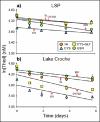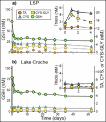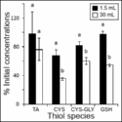Freshwater sample preservation for the analysis of dissolved low molecular mass thiols
| dc.contributor.author | Leclerc, Maxime | |
| dc.contributor.author | Planas, Dolors | |
| dc.contributor.author | Amyot, Marc | |
| dc.date.accessioned | 2020-04-06T16:02:34Z | |
| dc.date.available | NO_RESTRICTION | fr |
| dc.date.available | 2020-04-06T16:02:34Z | |
| dc.date.issued | 2017 | |
| dc.identifier.uri | http://hdl.handle.net/1866/23199 | |
| dc.publisher | Wiley | fr |
| dc.subject | Thiols | fr |
| dc.subject | Thioglycolic acid | fr |
| dc.subject | Cysteine | fr |
| dc.subject | Cysteine-glycine | fr |
| dc.subject | Glutathione | fr |
| dc.subject | Degradation | fr |
| dc.subject | Lakes | fr |
| dc.subject | Rivers | fr |
| dc.title | Freshwater sample preservation for the analysis of dissolved low molecular mass thiols | fr |
| dc.type | Article | fr |
| dc.contributor.affiliation | Université de Montréal. Faculté des arts et des sciences. Département de sciences biologiques | fr |
| dc.identifier.doi | 10.1002/lom3.10207 | |
| dcterms.abstract | Low molecular mass (LMM) thiols are ubiquitous organosulfur peptides that play key roles in biogeochemical element cycling. These LMM thiols, found at low concentrations in the water column, are highly sensitive to oxidation and degradation processes which may lead to problems with detection and analysis. Natural water samples should be stored and handled appropriately to reduce thiol loss in the time period from sampling to analysis. Storage temperatures were investigated for optimal preservation of four thiols species. Thiol degradation varied between species and was generally slower in samples stored at 2808C and 48C compared to 2208C and 218C. Two natural freshwater matrices were tested, one from a fluvial lake subject to agricultural inputs and one from an oligotrophic pristine lake. After 6 d of storage at 2208C, the most affected thiol species was glutathione with a degradation rate (kD) of (3.0 6 0.5) 3 1023 h21 in the fluvial lake water and Lcysteine-L-glycine (CYS-GLY) with a kD of (3.8 6 0.8) 3 1023 h21 in the oligotrophic lake water. Argon purging of samples did not prevent thiol degradation or oxidation after storage for 7 d. Pre-concentration by freeze-drying techniques led to significant loss for every thiol species tested (up to 65% for cysteine). We recommend improving storage methods by using temperatures of 2808C or 48C. The use of correction factors to estimate initial thiol concentrations is possible but should be used with caution due to highly site-specific kD in natural waters. | fr |
| dcterms.isPartOf | urn:ISSN:0024-3590 | fr |
| dcterms.isPartOf | urn:ISSN:1939-5590 | fr |
| dcterms.language | eng | fr |
| UdeM.ReferenceFournieParDeposant | https://doi.org/10.1002/lom3.10207 | fr |
| UdeM.VersionRioxx | Version acceptée / Accepted Manuscript | fr |
| oaire.citationTitle | Limnology and oceanography | |
| oaire.citationVolume | 15 | |
| oaire.citationStartPage | 875 | |
| oaire.citationEndPage | 886 |
Files in this item
This item appears in the following Collection(s)
This document disseminated on Papyrus is the exclusive property of the copyright holders and is protected by the Copyright Act (R.S.C. 1985, c. C-42). It may be used for fair dealing and non-commercial purposes, for private study or research, criticism and review as provided by law. For any other use, written authorization from the copyright holders is required.








